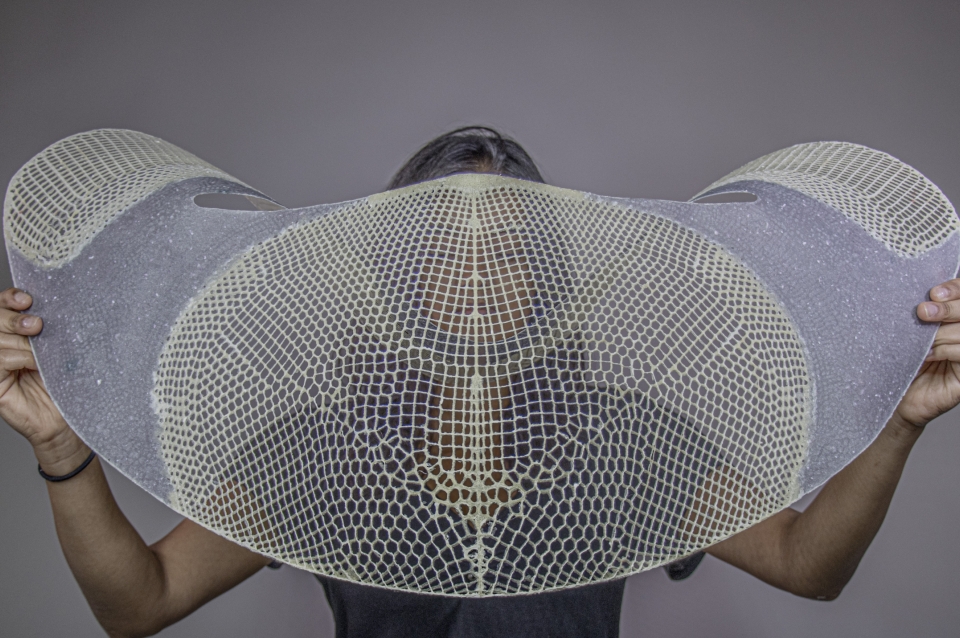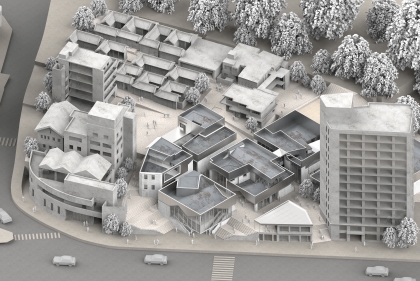
Sensbiom1, a temporary installation by DumoLab Research, sets forth the question of building materials being able to passively identify threats in air and correct their toxicity. Ribbons of folded oval lattices were aroma-infused and 2.5D-printed with water-based biocomposites and programmed to change the makeup of air towards human chemical wellbeing. In later iterations, Sensbiom2 used cell-free biology to manufacture air-active biosensors to detect volatile comppounds, and Sensbiom3 derived 200 color-active lattices forming a canopy responding in real-time to ultraviolet radiation during Milan Design Week. This work brings a new perspective on programmable matter responding to pressing needs for healthy and environmentally-friendly biomaterial systems bringing unprecedented function to product design and architecture. (PI: Dr. Laia Mogas-Soldevila; Team: Vlasta Kubušová, Danny Jarabek, Shivani Chawla, Victor Li, Abby Weinstein, Martina Bajteková, Soňa Otiepková, Liam Lasting, Camila Irabien, Gabriele Ho)
Close
Sensbiom1, a temporary installation by DumoLab Research, sets forth the question of building materials being able to passively identify threats in air and correct their toxicity. Ribbons of folded oval lattices were aroma-infused and 2.5D-printed with water-based biocomposites and programmed to change the makeup of air towards human chemical wellbeing. In later iterations, Sensbiom2 used cell-free biology to manufacture air-active biosensors to detect volatile comppounds, and Sensbiom3 derived 200 color-active lattices forming a canopy responding in real-time to ultraviolet radiation during Milan Design Week. This work brings a new perspective on programmable matter responding to pressing needs for healthy and environmentally-friendly biomaterial systems bringing unprecedented function to product design and architecture. (PI: Dr. Laia Mogas-Soldevila; Team: Vlasta Kubušová, Danny Jarabek, Shivani Chawla, Victor Li, Abby Weinstein, Martina Bajteková, Soňa Otiepková, Liam Lasting, Camila Irabien, Gabriele Ho)
Sea level rise resulting from climate change has put water supplies in tidal rivers and estuaries around the globe at risk of saltwater intrusion. Salt Cast, a digital salinity management tool in development, would enable coastal freshwater users and infrastructure planners to make better decisions. (Allison Lassiter, assistant professor of city and regional planning, co-principal investigator)
Developed by Francesca Russello Ammon, associate professor of city and regional planning and historic preservation, with Brian Goldstein and Garrett Dash Nelson, Sunset Over Sunset stitches together street-level views of ten miles of Sunset Boulevard made by American artist Ed Ruscha (one per decade between 1966 and 2007) and joins them with address-level historical demographic data, occupancy records, and newspaper coverage that go far beyond the visible facade. The result is a revelatory and fun archival resource for understanding urban change across space and time.
In 2017, the Center for Environmental Building and Design (CEBD), led by Professor of Architecture William Braham, joined up with the Mongolian nonprofit GerHub to test out ways of making ger living more energy efficient, in hopes of cutting down on air pollution and reducing respiratory conditions in Ulaanbaatar. The work evolved into a series of partnerships with UNICEF Mongolia, UNICEF Office of Innovation, design partners KieranTimberlake, The North Face and Arc’teryx, and research by two Weitzman School faculty, sponsored by the Kleinman Center for Energy Policy, on the long-term prospects of decarbonization in the city. The work has included building gers in Ulaanbaatar and at the Pennovation Center and monitoring their performance.
Research at Weitzman
Monday, September 16, 2024 - Friday, September 20, 2024
Meyerson Hall, 210 South 34 Street, Philadelphia
Open to members of the Penn community (PennKey required)

 View Slideshow
View Slideshow
